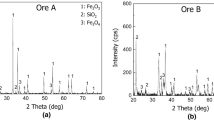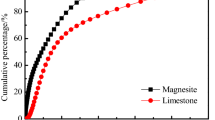Abstract
Sinter body strength, which reflects the strength of sinter, plays an important role in the improvement of sinter. In this study, the sinter body strengths of iron ores were measured using a microsintering method. The relationship between the chemical composition and sinter body strength was discussed. Moreover, sinter-pot tests were performed. The effects of sinter body strength on the sintering indexes were then elucidated, and the bottom limit of sinter body strength of blending ores was confirmed. In the results, the compressive strengths (CSs) of iron ores are observed to decrease with the increasing of the contents of loss on ignition (LOI), SiO2, and Al2O3; however, LOI of less than 3wt% does not substantially influence the CSs of fine ores. In the case of similar mineral composition, the porosity, in particular, the ratio between the number of large pores and the total number of pores, strongly influences the sinter body strength. With an increase of the blending-ore CSs used in sinter-pot tests, the yield, productivity, and tumbler strength increase, and the solid fuel consumption decreases. The CSs of the blending ores only slightly affect the sintering time. The CS bottom limit of the blending ores is 310 N. When the CSs of the blending ores increase by 10%, the yield, productivity, and tumbler index increase by 1.9%, 2.8%, and 2.0%, respectively, and the solid fuel consumption decreases by 1.9%.
Similar content being viewed by others
References
D.M. Newitt and J.M. Conway-Jones, A contribution to the theory and practice of granulation, Trans. Inst. Chem. Eng., 36(1958), p. 422.
A.G. Waters, J.D. Litster, and S.K. Nicol, A mathematical model for the prediction of granule size distribution for multicomponent sinter feed, ISIJ Int., 29(1989), No. 4, p. 274.
S.S. Rath, H. Sahoo, and B. Das, Optimization of flotation variables for the recovery of hematite particles from BHQ ore, Int. J. Miner. Metall. Mater., 20(2013), No. 7, p. 605.
G.L. Zhang, S.L. Wu, J. Zhu, and Y.Z. Wang, Influencing factors and mechanism of water absorption process of iron ores during sintering, Int. J. Miner. Metall. Mater., 21(2014), No. 2, p. 122.
E. Kasai and F. Saito, Differential thermal analysis of assimilation and melt-formation phenomena in the sintering process of iron ores, ISIJ Int., 36(1996), No. 8, p. 1109.
E. Kasai, S.L. Wu, and Y. Omori, Factors governing the strength of agglomerated granules after sintering, ISIJ Int., 31(1991), No. 1, p. 17.
L.X. Yang and L. Davis, Assimilation and mineral formation during sintering for blends containing magnetite concentrate and hematite/pisolite sintering fines, ISIJ Int., 39(1999), No. 3, p. 239.
J. Okazaki, K. Higuchi, Y. Hosotani, and K. Shinagawa, Influence of iron ore characteristics on penetrating behavior of melt into ore layer, ISIJ Int., 43(2003), No. 9, p. 1384.
S.L. Wu, Y. Liu, J.X. Du, K. Mi, and H. Lin, New concept of iron ores sintering basic characteristics, J. Univ. Sci. Technol. Beijing, 24(2002), No. 3, p. 254.
Z.X. Zhao, Y.D. Pei, W. Pan, H.B. Jiang, and H.G. Li, Influencing factors on high temperature properties of iron ore in Shougang, Iron Steel, 45(2010), No. 12, p. 12.
S.L. Wu, G.L. Zhang, S.G. Chen, and B. Su, Influencing factors and effects of assimilation characteristic of iron ores in sintering process, ISIJ Int., 54(2014), No. 3, p. 582.
S.L. Wu, D. Oliveira, Y.M. Dai, and J. Xu, Ore-blending optimization model for sintering process based on characteristics of iron ores, Int. J. Miner. Metall. Mater., 19(2012), No. 3, p. 217.
Y.D. Pei, Ore Proportioning during Sintering and Its Application Technology [Dissertation], University of Science and Technology Beijing, Beijing, 2008, p. 50.
S.L. Wu, Y.M. Dai, D. Oliveira, Y.D. Pei, J. Xu, and H.L. Han, Optimization of ore blending during sintering based on complementation temperature properties, J. Univ. Sci. Technol. Beijing, 32(2010), No. 6, p. 719.
M.S. Xue and X.M. Guo, Effect of Al2O3 and SiO2 on formation and crystal structure of calcium ferrite containing Al2O3 and SiO2, J. Chin. Rare Earth Soc., 26(2008), p. 205.
C.E. Loo and W. Leung, Factors influencing the bonding phase structure of iron ore sinters, ISIJ Int., 43(2003), No. 9, p. 1393.
L. Lu, R.J. Holmes, and J.R. Manuel, Effect of alumina on sintering performance of hematite iron ores, ISIJ Int., 47(2007), No. 3, p. 349.
Author information
Authors and Affiliations
Corresponding author
Rights and permissions
About this article
Cite this article
Zhang, Gl., Wu, Sl., Su, B. et al. Influencing factor of sinter body strength and its effects on iron ore sintering indexes. Int J Miner Metall Mater 22, 553–561 (2015). https://doi.org/10.1007/s12613-015-1107-x
Received:
Revised:
Accepted:
Published:
Issue Date:
DOI: https://doi.org/10.1007/s12613-015-1107-x




